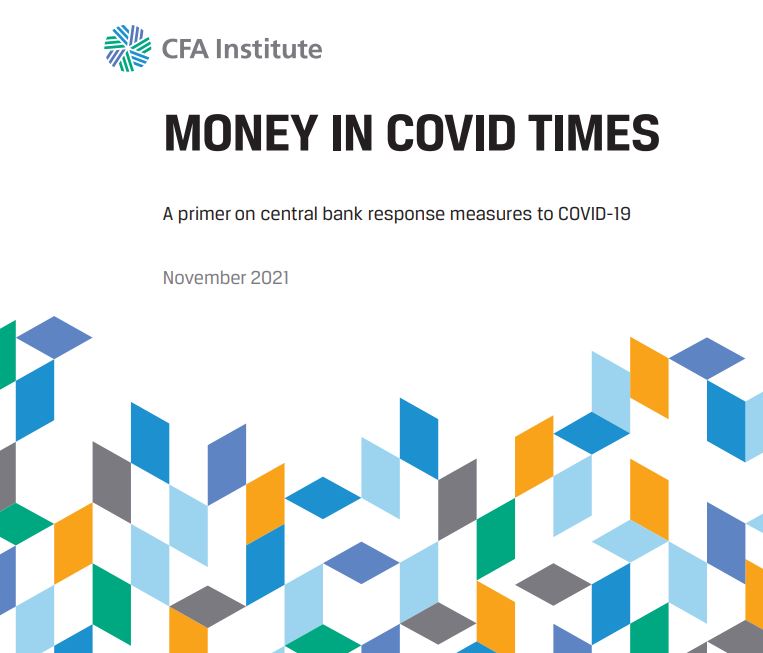
Money in COVID Times: A perfect storm forming for central banks?

The COVID-19 crisis is but the latest episode in a drama docuseries on economics depicting a world in which unorthodox monetary policy is becoming the norm rather than the exception.
How have central banks become the de facto lender and market maker of last resort in a financial market ecosystem in which market-based finance has now replaced traditional banking intermediation as the key channel for financing mechanisms?
Can monetary policy be normalised, or should we get used to a new normal of central bank interventionism as the bedrock of financial markets stability?
CFA Institute is releasing a white paper on the recourse to unorthodox monetary policy measures since the 2007–2009 Global Financial Crisis and now the COVID-19 crisis.

In the foreword to this paper, Simon Johnson, co-chair, CFA Institute Systemic Risk Council, reflects on the conundrum facing global policymakers:
We find ourselves at an important inflection point for the design of potential future global economic policy to deal with liquidity crises, global market contagion, or other systemic shocks.
“Money in COVID Times” is an analysis of how the role of central banks in the market and the economy has changed since 2008. From this perspective, the COVID-19 situation has only exacerbated the transformation of central banks into entities that act as lender and market maker of last resort, every time markets experience a level of stress that could reverberate across money markets, including credit and financial assets used as collateral. Together, the various stratums of money markets have replaced traditional banks as a supply chain for capital markets activity.
Some of the key questions that will need answering are as follows:
- At which point should central banks consider that the time is right to normalise monetary policy in line with the economic cycle?
- Should monetary policy and fiscal policy be coordinated?
- How important is central bank independence?
- Is there an objective limit to the extent of monetary stimulus?
Recent financial crises (2008, 2010, 2020) have shown that the typical maturity transformation process at the heart of the intermediation that the finance industry provides to the broader economy has shifted. Market-based finance has risen in prominence as a primary source of funding. Market-based finance (or non-bank financial intermediation) describes the funding of capital markets lending through short-term money markets, which constitutes the maturity transformation at the core of the market-based credit system. This system also has been called shadow banking.
To understand how this system works and operates, we also delve into the concept of money and the inherent hierarchy that underpins its structure.
In “The Role of the State and the Hierarchy of Money” (Stephanie Bell, March 2001), money is defined in the following way:
Money is credit (Innes, 1913). It represents a debt-relation, a promise or obligation, which exists between human beings and cannot be identified independently of its institutional usage. It expresses a social relation (Foley, 1987; Ingham, 1996) and will, following Keynes (1930), Minsky (1986) and Wray (1990), be treated as a two-sided balance sheet operation. Thus, the creation of money affects both assets and liabilities.
‘The Role of the State and the Hierarchy of Money’, Stephanie Bell, March 2001
Bell’s essay further establishes a direct connection between fiscal policy and money creation through the hierarchy of money:
The positioning of the state’s money at the top of the pyramid implies an intimate relationship between “the fiscal, tax-raising, authority on the one hand and money creation on the other” (Goodhart, 1997, p. 1). This relationship, when maintained, enables the use of counter-cyclical fiscal policy.
Recall that money represents a promise/IOU and that these promises can be created by anyone. The “secret” to turning these promises into money is getting other individuals or institutions to accept them. Therefore, the “hierarchy of money” can be thought of as a multi-tiered pyramid where the tiers represent promises with differing degrees of acceptability (Foley, 1987). At the apex is the most acceptable or “ultimate” promise.
Through an understanding of the hierarchy of money, we also appreciate how the shift to a market-based financial system has made crises more dependent on central banks assuming the role of market maker of last resort. Only central banks have the capacity to produce the most desirable type of money to stabilise collateral asset markets and to keep the system afloat. In our paper, we posit that this is what happened in the spring of 2020 in the United States when the Federal Reserve intervened. We are lifting the veil on the origin, the nature, and the impact of modern central bank interventionism. Understanding the hierarchy of money in times of crisis along with the tenets of market-based finance may lead us to reconsider our traditional acceptance of central banks’ role in financial markets and the economy at large. It may be the case that the current drive of accommodative monetary policy has simply become the new normal in a complex system that requires central banks to take on a more direct responsibility in the running and stabilisation of financial markets.
These considerations have never been as crucial as they are in today’s markets. The world is still debating the right policy stance for a successful post crisis economic recovery, even as the governments’ room for manoeuvre has been considerably reduced by record-high levels of public debt as a proportion of GDP in developed economies.
The conundrum facing central banks is severe. A perfect storm has formed, and monetary authorities are finding themselves in the eye of this money hurricane. How can central bankers normalise monetary policy without derailing the still-frail economic recovery? What is the risk of runaway inflation crystallising if they do not normalise? How do we enact efficient communication with the markets when this sharp double-edged sword of Damocles is hanging over their heads?
Another perplexing issue facing policymakers has to do with the supply side and the output gap generated by the economic lockdowns of the COVID-19 crisis. We have written about this problem in our latest COVID-19 research. It is not clear to what extent monetary policy can have an effective or measurable impact on the economics at play in the supply chain concerns observed at the moment. It is possible that a more direct relationship could be found with fiscal policy and economic support measures, which also are affecting labour, supply and production.
In such a context, it should come as no surprise that central bankers’ rhetoric has been dangling of late. Whether it be the Federal Reserve, the European Central Bank, or the Bank of England, monetary authorities initially were pointing to the possibility of higher structural tolerance for inflation before hinting at tapering options. The underlying bargaining agreement historically had generally been that monetary policy is primarily aimed at maintaining price and financial stability, thus providing markets with the loose assurance that monetary authorities will intervene to protect trust in the sovereign currency and in the future value of financial assets. Should this equation no longer hold, there could be repercussions for capital markets now largely driven by market-based finance, in terms of liquidity, fluidity and price formation. Ironically, this could result in an even stronger reliance on central banks to play their role as lender and market maker of last resort.
The COVID-19 crisis may have inadvertently triggered a reconfiguration of the traditional balance of powers between government-defined fiscal policy, monetary policy driven by central banks, and, ultimately, capital markets. We have yet to understand the form this reconfiguration will take, nor do we fully appreciate the extent of the new role played by public authorities in the free market economy.
If you liked this post, don’t forget to subscribe to the Market Integrity Insights blog.
Image credit: ©Getty Images/Andriy Onufriyenko
